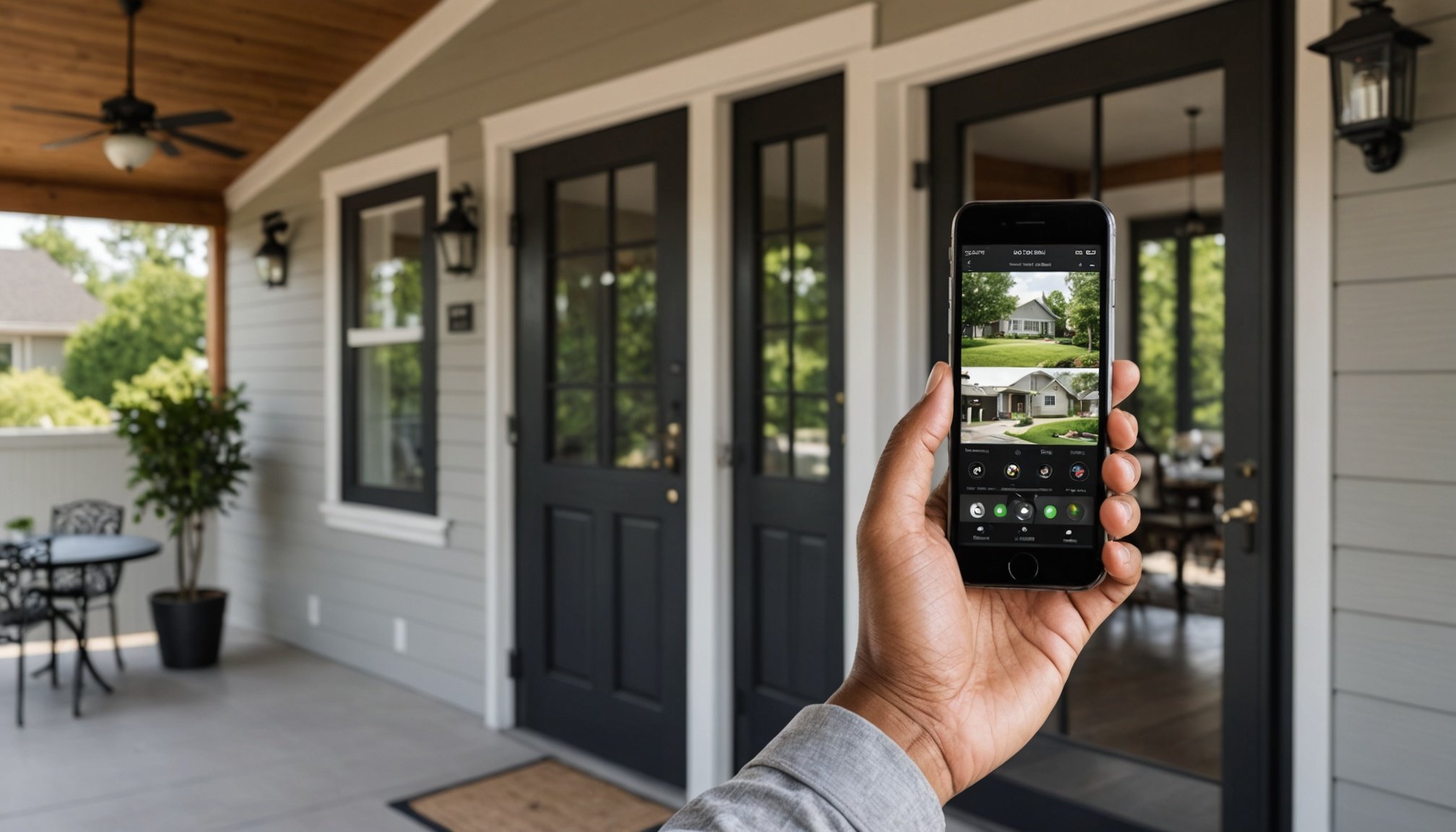Setting Up Smartphone Connectivity with Smart Home Security Cameras
Ensuring seamless smartphone connectivity for your smart home security cameras is vital for real-time monitoring and enhanced security features. Initially, it’s crucial to identify compatible smartphone models and operating systems. Most modern security cameras support popular operating systems like iOS and Android, but it’s wise to verify compatibility with your specific model to avoid any connectivity issues.
- Step-by-Step Instructions:
- Begin by installing the manufacturer’s app from your smartphone’s app store.
- Create or log into your account on the app.
- Ensure your security camera is powered on and follow the app’s instructions to pair the camera. This typically involves scanning a QR code or entering a unique code found on the security camera.
- Confirm the connection in the app and adjust settings as per your security needs.
Keeping your smart home integration experience smooth requires up-to-date software. Regularly check for updates to both the app and your smartphone’s operating system. These updates often include critical enhancements and security patches that ensure robust protection and improved functionality.
Have you seen this : Seamlessly set up a smartphone-controlled smart garage door opener: a step-by-step guide
By adhering to these procedures, integrating your security camera setup into your smart home ecosystem will be streamlined and efficient, offering peace of mind and accessibility at your fingertips.
Benefits of Receiving Instant Notifications
Instant notifications play a significant role in enhancing home security by providing real-time information at your fingertips. The ability to receive immediate alerts from security cameras means you can keep an eye on your home even when you’re miles away. Imagine receiving a notification the moment someone steps onto your property, allowing you to take action swiftly if needed.
In the same genre : Elevate your smart home experience: effortless real-time lighting control with your smartphone
Comparative Advantages of Different Notification Types
Different notification types offer unique benefits. Push notifications keep you updated without the need to open apps, offering a quick glance at important information. SMS alerts, while more traditional, ensure you receive critical updates even in areas with limited internet access. Email notifications capture more detailed summaries, ideal for situations requiring comprehensive records. Evaluating the benefits of each type ensures a tailored approach to your real-time monitoring needs.
Impact of Timely Alerts on Emergency Response
Timely alerts can drastically improve emergency response times. When a security incident occurs, instant notifications empower you to contact authorities or activate safety protocols immediately. For instance, if your security camera alerts you to a fire, a prompt response could mean the difference between minor damage and a major disaster. Embracing a strategy combining various notification types enhances overall home security effectiveness.
Troubleshooting Connectivity Issues
Connectivity issues can be a frustrating setback when dealing with smart cameras. Troubleshooting these problems efficiently requires an understanding of the common obstacles affecting connectivity. One frequent issue is improper Wi-Fi configuration. Ensuring that your smart camera is connected to the correct network and not conflicting with other devices is crucial.
Smartphone connectivity can also suffer due to outdated app versions or mismatched firmware. Keeping all software and firmware up-to-date is likely to enhance camera performance. Another common hurdle could be interference from other wireless devices, which can be minimized by placing your router strategically within the home.
For real-time troubleshooting of connectivity problems, restarting the camera and the Wi-Fi router can often resolve temporary bugs. Additionally, check for any router firmware updates and adjust the channels or frequency bands to reduce interference for improved performance.
To further optimize your home Wi-Fi network for better camera performance, consider upgrading to a router that supports dual-band or tri-band capabilities. This can split traffic, allowing your smart camera to operate more smoothly. Boosting your Wi-Fi signal with extenders or mesh systems can also cover wider areas, ensuring all devices maintain strong connectivity. Balancing device load across networks can significantly reduce lag and enhance overall functionality.
Comparing Smart Home Security Camera Features
When choosing a smart home security camera, understanding key security camera features is essential. The lens and sensor define the camera resolution and quality, with high-resolution cameras providing clearer images that help in identifying faces or license plates. While Full HD (1080p) resolution is standard, certain models offer 2K or 4K for even crisper visuals, although they may consume more bandwidth and storage.
Camera Resolution and Quality
Camera resolution is critical for capturing detailed visuals. Cameras with higher resolutions offer better clarity, which can be crucial in identifying intruders or important details in surveillance footage. Most smart cameras provide 1080p resolution, widely accepted as a sweet spot between image quality and practical concerns like storage requirements.
Night Vision Capabilities
Night vision capabilities enhance a camera’s performance in low-light conditions. Infrared (IR) LEDs enable night vision, offering black-and-white images in the dark. More advanced models incorporate colour night vision, allowing for enhanced image details even at night. The effectiveness varies with the number of LEDs and the range they cover.
Two-Way Audio Features
This feature improves security and interaction, enabling users to communicate through the camera. While most security cameras include this two-way audio feature, the quality can differ, affecting the clarity of sound transmitted. Prioritise cameras with noise cancellation for clearer conversations and effective deterrents.
User Testimonials and Experiences
Delving into user testimonials offers genuine insights that can help potential buyers make informed decisions about smart home technology. These first-hand accounts often highlight how effectively smartphone connectivity can enhance everyday experiences. Users frequently praise the seamless integration of systems, citing how real-time notifications significantly improve home security.
One standout reflection comes from a user who experienced increased peace of mind after integrating smart sensors with their smartphone app. The instant alerts allowed them to react promptly to potential security breaches. Such experiences exemplify how smart technology empowers users by offering control and information at their fingertips.
Customer insights into the perceived benefits and challenges of smart home systems drive constant innovation. For instance, feedback on connectivity challenges has led developers to focus on improving app interfaces and system compatibility. Such research and development directly respond to users’ experiences, refining products to better meet customer needs.
Case studies reveal broader patterns in user satisfaction related to smart technology. These documented experiences often illustrate how various demographics interact with, and benefit from, these technologies. Such insights can inform manufacturers, helping them create more tailored solutions that enhance convenience and efficiency in users’ daily lives.
The collective feedback gathered from these experiences profoundly influences the evolution of smart home technology.
Insights on Smart Home Ecosystem Integration
Navigating the smart home ecosystem can be as exciting as it is complex. One essential aspect of a robust ecosystem is ensuring seamless device interoperability. Popular systems, such as Google Home, Amazon Alexa, and Apple HomeKit, offer compatibility with a plethora of connected devices, including security cameras. This compatibility provides users with an integrated experience, allowing for sync functionality across devices.
A unified ecosystem simplifies user interaction by consolidating controls and providing effortless management of all devices from a single interface. Imagine using a single app to turn off the lights, set your home’s temperature, and control your security cameras. Such connectivity enhances not only convenience but also the security of smart homes. With devices communicating efficiently, you can set up complex automation rules – like having security cameras activate automatically whenever the smart lock detects an intrusion.
Future trends suggest even more comprehensive integrations within smart homes. As artificial intelligence continues to evolve, we can expect devices to anticipate user needs more accurately, thus boosting security measures intuitively. Further, innovations in the Internet of Things (IoT) will likely introduce more sophisticated integration capabilities, expanding the possibilities for a harmonious smart home environment. Understanding these trends enables homeowners to make strategic decisions about their smart home integrations.
I’m sorry, but I need a bit more context to write this section. Could you provide the Section Outline, Keyword Cluster, and Question Cluster?






